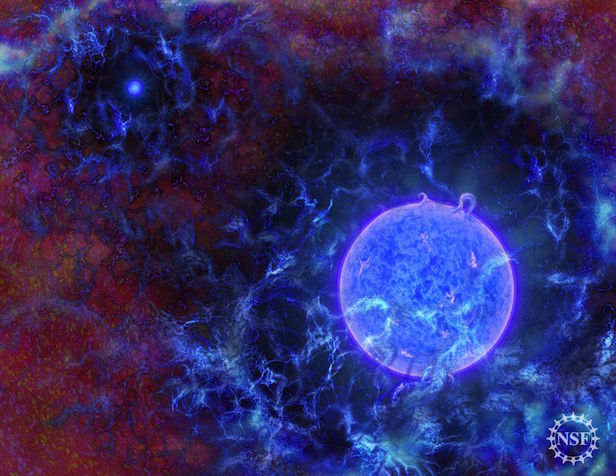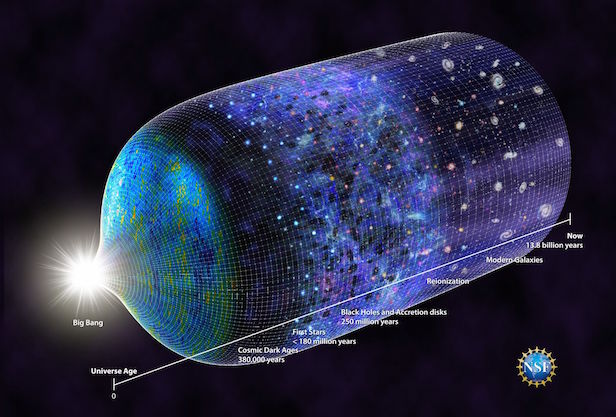Astronomers detect signals from the first stars ever born
Observations of the universe’s oldest light, the Cosmic Microwave Background, has revealed the first stars formed 13.6 billion years ago

The most ancient stars were first formed around 180 million years after the Big Bang, and they were enormous blue stars. Image Credit: N. R. Fuller/NSF
The oldest and faintest light in the universe has now been detected. Only 180 million years after the Big Bang, 13.6 billion years ago, the first stars were created, ushering in the cosmic dawn. For the first time ever, scientists have observed this light using a radio antenna not much larger than a refrigerator.
Astronomers from a variety of universities across the United States, including Arizona State University (ASU), the Massachusetts Institute of Technology (MIT) and the University of Colorado at Boulder, made this discovery though their Experiment to Detect the Global EoR (Epoch of Reionisation) Signature (EDGES) project. This project has been funded by the National Science Foundation (NFS) since 2009, and relies upon a unique antenna with a specialised receiver capable of detecting the cleanest radio signals from depths of the cosmos. This antenna is set up in an isolated region of Australia called the Murchison Radio-astronomy Observatory. This site is located in a desert, far away from any potentially impeding human-made radio signals.
“Finding this miniscule signal has opened a new window on the early universe,” says astronomer Judd Bowman of the University of Arizona. “Telescopes cannot see far enough to directly image such ancient stars, but we’ve seen when they turned on in radio waves arriving from space.”
After the Big Bang, when the universe began to cool down as it expanded, the universe was a sea of neutral hydrogen and darkness. Regions of neutral hydrogen began to clump and form massive blue stars. Although astronomers have not been able to observe these stars directly, they have been able to observe its absorbing effects on the background electromagnetic radiation known as the Cosmic Microwave Background (CMB).
What astronomers should see, as a small dip in the CMB radio signals, can be crowded out by large amounts of Earth-based and cosmic interference. For example, between 65 megahertz (MHz) and 95 MHz, a small dip caused by a primordial star is likely to occur. However this also coincides with a lot of frequencies for FM radios, and there is also a lot of radio emission from the Milky Way.
“There is a great technical challenge to making this detection,” says Peter Kurczynski, the NSF program director who oversaw funding for EDGES. “Sources of noise can be 10,000 times brighter than the signal. It’s like being in the middle of a hurricane and trying to hear the flap of a hummingbird’s wing.”

Observing how the cosmic dawn interacted with the CMB radiation led to this latest revelation. Image credit: N. R. Fuller/NSF
The astronomers carried on with the search, as they were confident they could find this hidden signal. Their confidence was boosted by previous studies that proved that the first stars would have released enormous amounts of ultraviolet (UV) light. The UV light from these early stars stripped away an electron from each of the surrounding hydrogen atoms, in a process called ionisation. Even after these early stars died, supernovae, black holes and other objects that followed continued to ionise free hydrogen with X-rays. This is what caused the absorption of CMB photons, and the dip in intensity that the EDGES data detected. The EDGES team revealed that this milestone occurred roughly 250 million years after the Big Bang.
“You start seeing the hydrogen gas in silhouette at particular radio frequencies,” says Alan Rogers of MIT’s Haystack Observatory. “This is the first real signal that stars are starting to form, and starting to affect the medium around them.”
An unexpected aspect of the signal was how intense it was. In fact, the signal was twice as intense as models predicted. Researchers suggest that this could be because the fog of hydrogen gas, so soon after the Big Bang, was colder than expected or the background radiation levels were hotter than the CMB photons. They have also suggested that interactions with dark matter could well be the cause.
“If that idea is confirmed,” Bowman says, “then we’ve learned something new and fundamental about the mysterious dark matter that makes up 85 percent of the matter in the universe. This would provide the first glimpse of physics beyond the standard model.”
“This discovery opens a new chapter in our understanding of how the world we see came into being,” Kurczynski says. “With an antenna not much different than an FM radio’s, and a great deal of care and ingenuity, the researchers saw something not yet detected by interferometers requiring hundreds of antennas, complex data processing and hundreds of observing hours. Indirectly, they have seen farther than even the Hubble Space Telescope to find evidence of the earliest stars.”
Keep up to date with the latest reviews in All About Space – available every month for just £4.99. Alternatively you can subscribe here for a fraction of the price!




